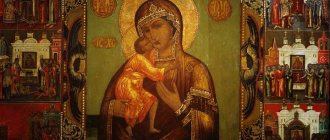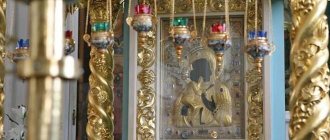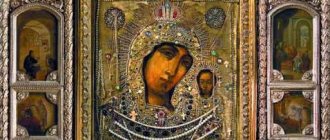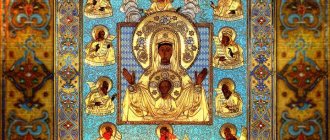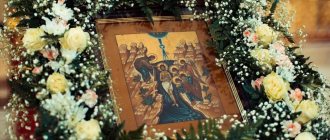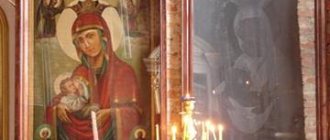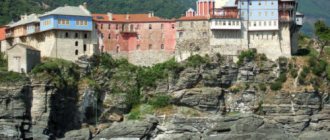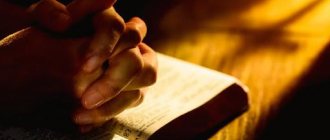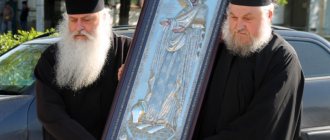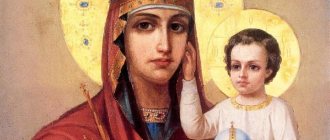Icon saved from fire
Shortly before his death, the emperor (his image is given below) presented it as a gift to a Greek monastery located on the Peloponnese peninsula. There, under the arches of the ancient monastery, the Andronikovskaya Icon of the Mother of God was kept until the invasion of the Turks, who captured the peninsula in 1821 and destroyed the monastery.
The Ottoman conquerors plundered all the valuables stored in the monastery, and what they could not take out was set on fire. Only the icon, once a gift from the Byzantine emperor, was miraculously preserved. She was saved from the hands of infidels by the abbot of the monastery, Bishop Agapius. At the risk of his life, he took the shrine to the city of Patras (the modern name of Patras), free from invaders, and there he handed it over to his relative, Russian consul A.N. Vlassopoulo.
The icon, painted on a wooden board, had a very small size ─ 35 cm x 25 cm. The Most Holy Theotokos was depicted on it alone without Her Eternal Child. A characteristic feature of the image was the bleeding wound on the neck of the Mother of God, left after a spear strike inflicted in the 8th century, when Byzantium was engulfed in the fire of iconoclasm.
Road to Russia
In 1839, the icon of the Andronikovskaya Mother of God was sent from Greece to St. Petersburg by the son and heir of the consul who had died by that time. Upon arrival in the capital of the Russian Empire, the shrine was located in the house church of the Winter Palace until 1868, and then for some time in the Trinity Cathedral, located on the Petrograd side. It is believed that in those same years an akathist to the Andronikov Icon of the Mother of God was compiled.
In April 1877, the holy image was sent to Vyshny Volochok, where it was received with extraordinary honors by the local clergy and townspeople. After the solemn service in the Kazan Cathedral, the shrine was transferred in a religious procession to a convent located not far from the city, founded in honor of the Kazan Icon of the Mother of God.
Description and iconography of the holy face
The iconographic type of the Andronikov Icon of the Mother of God is “Agiosoritissa”. This type of iconography is characterized by the image of the Mother of God without the Infant. The Blessed Virgin is depicted in a three-quarter turn. The image is half-length. The pose of the Mother of God is prayerful.
The size of the holy image is small - 25x35 cm. The holy face has many contrasts: the shaded face of the Most Pure Virgin is decorated with a bright halo and crown, the sad and humble look is complemented by kindness and peace.
The sad look of the Mother of God is filled with kindness and humility
The clothes are characterized by a bright orange hue, which in those days was considered imperial. The embroidered double-headed eagle, which is the Byzantine coat of arms, testified to the imperial origin of the shrine. Embroidery depicting the imperial coat of arms was included with the icon.
Miracles revealed in the Feodorovsky Monastery
After the icon of the Andronikovskaya Mother of God took pride of place in the main church of the monastery, its abbess, Abbess Dosithea, petitioned the Holy Synod to establish an official day of celebration dedicated to the acquired shrine. Soon her request was granted, and since then, celebrations dedicated to this icon have been held annually on May 1.
There is evidence that the prayer to the Andronikov Icon of the Mother of God often brought the fulfillment of the most cherished and difficult desires. The monastery book is full of records about the healing of hopelessly sick people, about finding family happiness and successful childbearing. It is not surprising that after this the image began to be revered as miraculous.
Prayer to the Shrine
Before the Andronikovskaya icon you need to offer the following prayer:
“Oh, Most Holy Lady Theotokos! Thou art the Highest of all Angels and Archangels, and of all creatures, the Most Honest: Thou art the Helper of the offended, the hopeless Hope, the poor Intercessor, the sad Consolation, the hungry Nurse, the naked Robe, the sick Healing, Salvation of sinners, Help and Intercession of all Christians. Oh, All-Merciful, Lady and Lady Theotokos! Raise us from the depths of sin, and deliver us from famine, destruction, from cowardice and flood, from fire and sword, from the presence of foreigners and internecine warfare, and from sudden death, and from attacks of the enemy, and from all evil. Grant, O Lady, peace and health to Thy servant, all Orthodox Christians, and enlighten their minds and the eyes of their hearts to salvation, and make us, Thy sinful servants, worthy of the Kingdom of Thy Son, Christ our God, with His Father without beginning, and with the Most Holy and His Good and Life-giving Spirit, now and ever and unto ages of ages. Amen."
Fig. 4 The petition to the Mother of God should be pronounced with a pure heart and true faith. Otherwise, holy ascensions and lit candles will be meaningless.
It is recommended to read the prayer in an undertone, in a slightly chanting tone, placing the correct emphasis on each word, otherwise the entire meaning of the prayer may be distorted. A secluded place is chosen for this, away from prying eyes. You can’t pray just on a whim or at someone’s direction; everything should come only from the heart.
Years of Bolshevik rule
This continued until the tragic events of 1917, which radically changed the entire way of life in Russia. With the coming to power of the atheistic forces, the women's monastery was closed. Most of the buildings located on its territory were destroyed, and those that, according to the authorities, were of economic value were rebuilt and used for the needs of the military unit located there.
Two miraculous icons of the Mother of God that were kept in the monastery before its defeat, Andronikovskaya and Kazanskaya, were transferred to the only city church that remained open at that time. This was the same Kazan Cathedral, which in 1877 became the site of celebrations on the occasion of the arrival from St. Petersburg of the image painted by the hand of the Evangelist Luke.
The fate of this temple is very sad. Having successfully survived all the decades of communist rule with their regular anti-religious campaigns, it was destroyed in 1993, when, in the wake of perestroika, the Churches were returned and thousands of devastated and desecrated shrines were restored. The church utensils, vestments and icons located in it were transferred to another city church ─ Epiphany. The icon of the Andronikovskaya Mother of God was also placed there in the early 80s.
Andronikovskaya Icon of the Mother of God in Pereslavl-Zalessky
The news of the appearance of a stolen icon in Pereslavl spread throughout the country in 2005. However, as it turned out, it was not true. The reason for its appearance was events that in themselves deserve attention. It all started back in 1998, when one of the parishioners brought to the church of the Pereslavl-Zalessky Feodorovsky Convent a life-size lithographic copy of the stolen Andronikov icon (photo below). After some time, another woman donated an icon case to the monastery, its size exactly matching the previously brought lithograph.
The icon thus acquired was placed in the temple, but since it did not represent any artistic or historical value, its appearance went unnoticed. This continued until 2005, when the lithograph, according to eyewitnesses, began to emit a wonderful fragrance that filled the entire temple.
An inexhaustible source of miracles
Moreover, in subsequent times, numerous miracles of healing were recorded, revealed through prayers before her. This caused an extraordinary stir among believers and served as a reason to consider the lithographic copy as miraculous as its stolen original. The celebration of the day of the newly found icon takes place on May 14 and November 4.
A year later, the Andronikov Icon, or rather its lithographic copy, began to stream myrrh abundantly, which gave it universal fame and, accordingly, increased the number of pilgrims. For the information of skeptics, we note that there is a lot of evidence of people living today who received healing from ailments after their visit to the Feodorovsky Monastery, where the Andronikov Icon of the Mother of God is still located.
What they pray for before her can be clearly seen from the text of the short prayer given along with the photograph that opens the article. The main thing is the petition for the intercession of the Mother of God for us before the Throne of the Most High, who bestows life, health and all earthly blessings.
Story
John was the son of an elderly, long-infertile couple, the temple priest Zechariah and the righteous Elizabeth, who was a relative of the Virgin Mary herself.
The family lived in the town of Ein Kerem, near Jerusalem. Now there is a Church of the Visitation here. It is built on the spot where the Virgin Mary and Elizabeth met when they were both pregnant. Mary then went home, and Elizabeth gave birth to John a few months later. Another church is located right where John's house was.
Soon after his birth, Herod ordered that all babies be killed. According to legend, Elizabeth took her son and left to hide him somewhere. And then the mountain opened up before her and she was able to hide there and save John.
And Zechariah, his father, as a priest, took part in services and rituals in the Jerusalem temple. Perhaps John himself became a priest. But in heart and soul he was more like the prophets of the Old Testament.
The 20th-century Jewish philosopher Abraham Heschel spoke of prophets as people with special ears who could hear things that other people could not hear.
Christian traditions place John the Baptist among such prophets as Elijah, Jeremiah, Isaiah - those who had this inner ear, receptive to the word of the Lord.
At the age of 30, John hears the Lord’s call to a special ministry. He must become the voice of one crying in the wilderness, the forerunner of the Messiah. He retires to the Judean desert and, dressed in clothes made of camel's hair, lives there as a strict ascetic and ascetic.
John lives and preaches near a river crossing in what is now Jordan. On the east bank of the Jordan River, his speeches resonate among the people of the country. Dozens of people come to listen to the prophet, because Israel has long lived in anticipation of the Messiah, the true king from the line of David.
We advise you to study Prayers for Marriage
And now John says to them:
He calls on everyone:
John preaches Baptism-Repentance for the forgiveness of sins and performs the ritual of immersion in the water of the Jordan River, which has always been considered the border of the Holy Land. Just as water washes the body, Repentance cleanses the soul.
John reminds his fellow tribesmen of one of the greatest prophets of the past - Elijah, who lived 8 centuries earlier. Not only did he preach in the same section of the Jordan River where Elijah lived, but he also dressed like Elijah—minimal clothing. He ate like Ilya. He even had a long beard, like Ilya.
John the Baptist came to fulfill the mission of the prophet Elijah; he was not his physical embodiment. Christ Said:
Soon a whole community of followers gathers around John, and two Galilean fishermen who came here, having traveled tens of kilometers on foot, Andrew and John from Bethsaida, also become his disciples.
Soon, Jesus of Nazareth himself appears among the crowd on the banks of the Jordan. Thanks to prophetic powers, John realized who was in front of him. Christ asks to baptize him.
The sinless Jesus compares himself with fallen, lost people in order to share with them the burden of sins and bring healing to their souls. Having received the Revelation about Jesus Christ, he tells the people about him:
John, in his speeches, increasingly begins to criticize the power of King Herod. And he begins to fear that John’s power over the masses might lead to unrest.
John criticized Herod for divorcing his first wife and marrying his brother's wife. We can also assert, based on the materials of the historian Josephus, that John did not approve of Herod’s actions at the political level.
John was imprisoned in a fortress. But even here he is not going to remain silent and continues to remain a threat to the royal family. Herodias, the same second wife of the king, is looking for a reason to deal with her enemy. She worries that the king disappears at night in prison, talking with John.
A suitable opportunity arose soon, during the celebration of the birthday of King Herod. The daughter of Herodias, Salome, danced in front of the guests. Her fiery dance delights the birthday boy. Herod promises her as a reward everything that she does not ask for. And she, after consulting with her mother, asks for the severed head of John on a golden platter. The head was presented as a gift to Salome, who took the dish and placed it at the feet of her mother Herodias. Thus, John the Baptist died as an unbending witness of the Truth of God.
